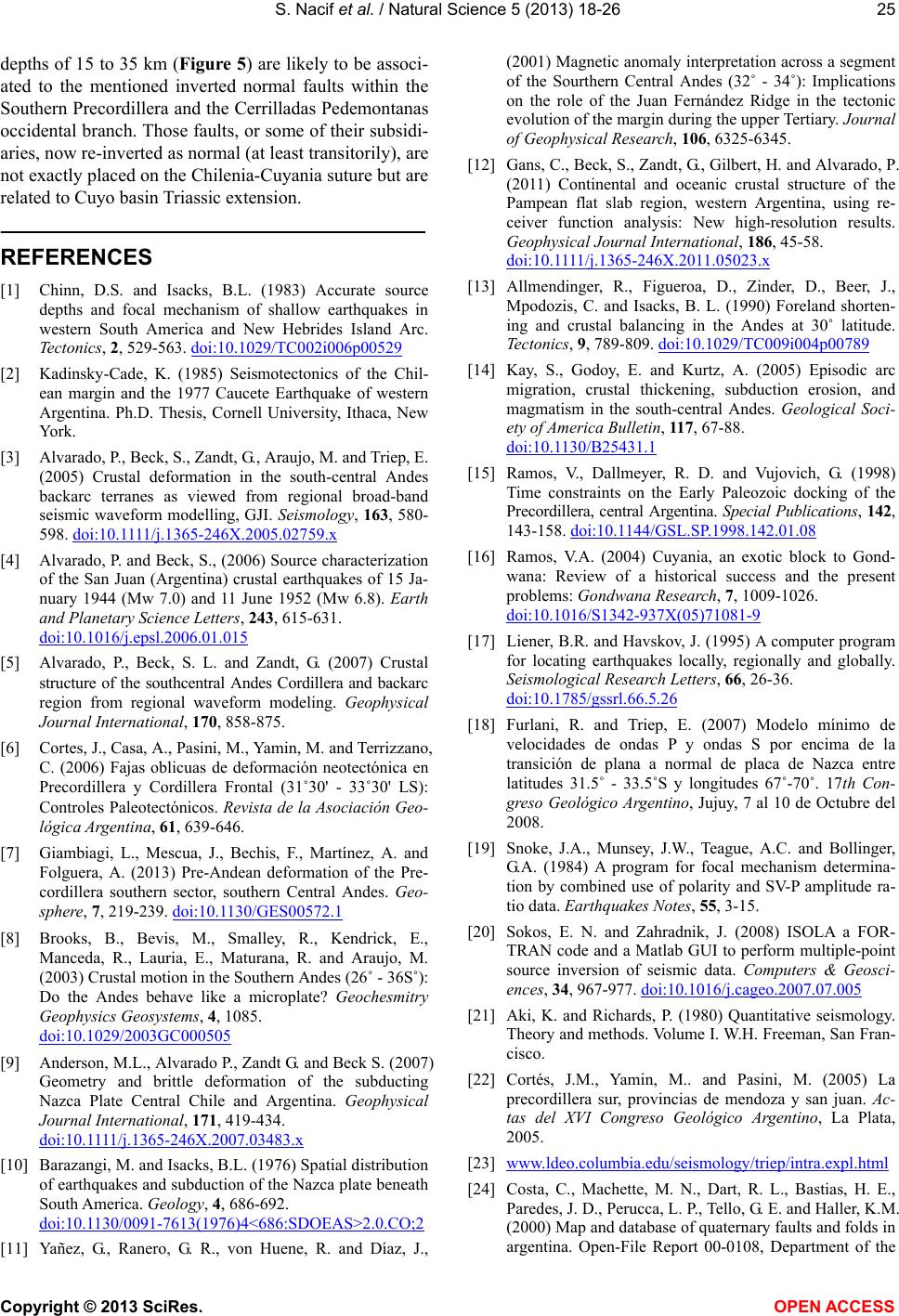
S. Nacif et al. / Natural Science 5 (2013) 18-26 25
depths of 15 to 35 km (Figure 5) are likely to be associ-
ated to the mentioned inverted normal faults within the
Southern Precordillera and the Cerrilladas Pedemontanas
occidental branch. Those faults, or some of their subsidi-
aries, now re-inverted as normal (at least transitorily), are
not exactly placed on the Chilenia-Cuyania suture but are
related to Cuyo basin Triassic extension.
REFERENCES
[1] Chinn, D.S. and Isacks, B.L. (1983) Accurate source
depths and focal mechanism of shallow earthquakes in
western South America and New Hebrides Island Arc.
Tectonics, 2, 529-563. doi:10.1029/TC002i006p00529
[2] Kadinsky-Cade, K. (1985) Seismotectonics of the Chil-
ean margin and the 1977 Caucete Earthquake of western
Argentina. Ph.D. Thesis, Cornell University, Ithaca, New
York.
[3] Alvarado, P., Beck, S., Zandt, G., Araujo, M. and Triep, E.
(2005) Crustal deformation in the south-central Andes
backarc terranes as viewed from regional broad-band
seismic waveform modelling, GJI. Seismology, 163 , 580-
598. doi:10.1111/j.1365-246X.2005.02759.x
[4] Alvarado, P. and Beck, S., (2006) Source characterization
of the San Juan (Argentina) crustal earthquakes of 15 Ja-
nuary 1944 (Mw 7.0) and 11 June 1952 (Mw 6.8). Earth
and Planetary Science Letters, 243, 615-631.
doi:10.1016/j.epsl.2006.01.015
[5] Alvarado, P., Beck, S. L. and Zandt, G. (2007) Crustal
structure of the southcentral Andes Cordillera and backarc
region from regional waveform modeling. Geophysical
Journal International, 170, 858-875.
[6] Cortes, J., Casa, A., Pasini, M., Yamin, M. and Terrizzano,
C. (2006) Fajas oblicuas de deformación neotectónica en
Precordillera y Cordillera Frontal (31˚30' - 33˚30' LS):
Controles Paleotectónicos. Revista de la Asociación Geo-
lógica Ar gentina , 61, 639-646.
[7] Giambiagi, L., Mescua, J., Bechis, F., Martínez, A. and
Folguera, A. (2013) Pre-Andean deformation of the Pre-
cordillera southern sector, southern Central Andes. Geo-
sphere , 7, 219-239. doi:10.1130/GES00572.1
[8] Brooks, B., Bevis, M., Smalley, R., Kendrick, E.,
Manceda, R., Lauria, E., Maturana, R. and Araujo, M.
(2003) Crustal motion in the Southern Andes (26˚ - 36S˚):
Do the Andes behave like a microplate? Geochesmitry
Geophysics Geosystems, 4, 1085.
doi:10.1029/2003GC000505
[9] Anderson, M.L., Alvarado P., Zandt G. and Beck S. (2007)
Geometry and brittle deformation of the subducting
Nazca Plate Central Chile and Argentina. Geophysical
Journal International, 171, 419-434.
doi:10.1111/j.1365-246X.2007.03483.x
[10] Barazangi, M. and Isacks, B.L. (1976) Spatial distribution
of earthquakes and subduction of the Nazca plate beneath
South America. Geology, 4, 686-692.
doi:10.1130/0091-7613(1976)4<686:SDOEAS>2.0.CO;2
[11] Yañez, G., Ranero, G. R., von Huene, R. and Díaz, J.,
(2001) Magnetic anomaly interpretation across a segment
of the Sourthern Central Andes (32˚ - 34˚): Implications
on the role of the Juan Fernández Ridge in the tectonic
evolution of the margin during the upper Tertiary. Journal
of Geophysical Research, 106, 6325-6345.
[12] Gans, C., Beck, S., Zandt, G., Gilbert, H. and Alvarado, P.
(2011) Continental and oceanic crustal structure of the
Pampean flat slab region, western Argentina, using re-
ceiver function analysis: New high-resolution results.
Geophysical Journal International, 186, 45-58.
doi:10.1111/j.1365-246X.2011.05023.x
[13] Allmendinger, R., Figueroa, D., Zinder, D., Beer, J.,
Mpodozis, C. and Isacks, B. L. (1990) Foreland shorten-
ing and crustal balancing in the Andes at 30˚ latitude.
Tectonics, 9, 789-809. doi:10.1029/TC009i004p00789
[14] Kay, S., Godoy, E. and Kurtz, A. (2005) Episodic arc
migration, crustal thickening, subduction erosion, and
magmatism in the south-central Andes. Geological Soci-
ety of America Bulletin, 117, 67-88.
doi:10.1130/B25431.1
[15] Ramos, V., Dallmeyer, R. D. and Vujovich, G. (1998)
Time constraints on the Early Paleozoic docking of the
Precordillera, central Argentina. Special Publications, 142,
143-158. doi:10.1144/GSL.SP.1998.142.01.08
[16] Ramos, V.A. (2004) Cuyania, an exotic block to Gond-
wana: Review of a historical success and the present
problems: Gondwana Research, 7, 1009-1026.
doi:10.1016/S1342-937X(05)71081-9
[17] Liener, B.R. and Havskov, J. (1995) A computer program
for locating earthquakes locally, regionally and globally.
Seismological Research Letters, 66, 26-36.
doi:10.1785/gssrl.66.5.26
[18] Furlani, R. and Triep, E. (2007) Modelo mínimo de
velocidades de ondas P y ondas S por encima de la
transición de plana a normal de placa de Nazca entre
latitudes 31.5˚ - 33.5˚S y longitudes 67˚-70˚. 17th Con-
greso Geológico Argentino, Jujuy, 7 al 10 de Octubre del
2008.
[19] Snoke, J.A., Munsey, J.W., Teague, A.C. and Bollinger,
G.A. (1984) A program for focal mechanism determina-
tion by combined use of polarity and SV-P amplitude ra-
tio data. Earthquakes Notes, 55, 3-15.
[20] Sokos, E. N. and Zahradnik, J. (2008) ISOLA a FOR-
TRAN code and a Matlab GUI to perform multiple-point
source inversion of seismic data. Computers & Geosci-
ences, 34, 967-977. doi:10.1016/j.cageo.2007.07.005
[21] Aki, K. and Richards, P. (1980) Quantitative seismology.
Theory and methods. Volume I. W.H. Freeman, San Fran-
cisco.
[22] Cortés, J.M., Yamin, M.. and Pasini, M. (2005) La
precordillera sur, provincias de mendoza y san juan. Ac-
tas del XVI Congreso Geológico Argentino, La Plata,
2005.
[23] www.ldeo.columbia.edu/seismology/triep/intra.expl.html
[24] Costa, C., Machette, M. N., Dart, R. L., Bastias, H. E.,
Paredes, J. D., Perucca, L. P., Tello, G. E. and Haller, K.M.
(2000) Map and database of quaternary faults and folds in
argentina. Open-File Report 00-0108, Department of the
Copyright © 2013 SciRes. OPEN ACCESS